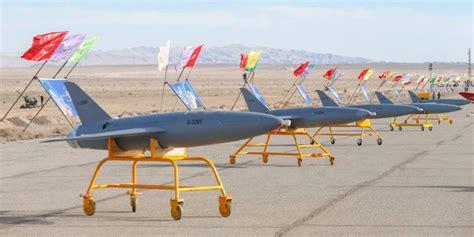
Iran Unveils Jet-Powered Version Of Shahed Kamikaze Drone
Iranian state television has revealed the existence of a new one-way attack drone: a jet-powered version of the Shahed series, the drones which Russia has used to pound Ukraine. The current Shahed-136 is driven by a propeller, with a puttering piston engine earning it the nickname ‘flying moped.’ The new version will be far faster and more difficult to intercept.
Flag Bearer
The drone appears in the trailer for a documentary called “Parchamdar” – meaning, roughly, ‘flag-bearer’ – out in October. It celebrates Iran’s long history of drone development and production. After the revolution in 1979, the US cut ties with Iran, and the Iranian Air Forces’ US-supplied aircraft became difficult to service (though it’s had remarkable success keeping some of its F-14 Tomcat fighters flying). Iranian students making model radio-controlled aircraft realized they could be used for reconnaissance in the war with Iraq, and a new national industry was born.
Drones have become not just a vital part of Iran’s defence forces, but a key tool in its foreign policy. Supplying favored allies with drones gives Iran leverage in international conflicts without the need for direct involvement, and the drone industry means allies can obtain weapons from Iran which nobody else will supply. So the Houthis in Yemen are able to hit airports and oil refineries in Saudi Arabia with Iranian-supplies Samads, and the Hezbollah militants in Lebanon and Iranian-backed militias in Iraq get high-tech weapons to help their cause.
Iran’s drone exports took a surprising turn last year when, despite official denials, it became obvious that Russia was using Iranian Shahed-131 and -136 drones. Russia has fired some 2,000 imported Shaheds at Ukraine and is now setting up a giant factory to assemble them inside Russia on a much larger scale.
Jet-Powered ‘Moped’
The documentary Parchamdar was officially unveiled this week by the commander of the Revolutionary Guard Aerospace Force, which has played a key role in drone development for decades. The trailer shows a wide range of drones, but even this is fraction of the total; according to analysts Oryx, some 143 types have been seen over the years.
It includes six seconds of clips of a new version of the Shahed, which does not have the propeller seen in the previous versions.
This new version does not come as a great surprise. In 2021 we noted the international concern when Iran unveiled the Ranseh-1 (“Propulsion-1”) micro turbojet for drones and cruise missiles alongside other new developments. Turbojets, one of the earliest types in jet evolution, offer vastly more power for their size and weight than piston engines. They are less fuel efficient than turbofans, but the power and simplicity make them attractive for some military applications. The French-made Storm Shadow missile used so effectively in recent Ukrainian attacks is driven by a small but powerful Microturbo TRI-60-30 engine, giving it a top speed of over 600 mph.
The jet-powered Shahed appears to have similar dimensions to the earlier versions, but due to the relatively thirsty turbojet its range may be far less than the 1,200 miles reported for the Shahed-136.
The turbojet will provide speed and altitude. While the Shahed-136 cruises at around 120mph, slow enough to be engaged by anti-aircraft guns and even Kalashnikovs , the jet drone will come in at much greater speed. A large percentage of Shaheds are shot down, many by Gepard flakpanzers with twin automatic cannon. In one recent attack the defenders accounted for 26 out of the 38 attacking Shaheds, but a faster version may get through in larger numbers.
However, the jet engine does come with other disadvantages: the high heat output will make it more obvious to thermal imagers and a much easier target for heat-seeking missiles.
Camera Guidance
Iranian Twitter user Meshkat noted a less obvious feature of the new drone: it appears to have a nose-mounted camera. This is a novelty, as the previous Shaheds have all relied on satellite guidance to hit pre-programmed co-ordinates.
The camera may be used in two ways. It might be there to enable visual navigation, like a modern version of the Digital Scene Matching Area Correlator developed for the Tomahawk cruise missile way in the 1970s. This looks at the territory below and works out where it is on the map by comparing landmarks, making it immune to GPS/GNSS jamming.
Alternatively the camera may enable terminal guidance, either controlled by an operator or with a machine-vision system to identify and lock on to a target feature such a specific building. In the video the Shahed is seen hitting a target with extreme precision; this is typical of videos of test firings and no indication of the actual performance. But is it possible the new version will be a significant upgrade.
Russian Market?
The big selling point of the original Shaheds has been their low cost and ease of manufacture. Replacing a cheap, simple weapon with a more costly and complex one may not make sense. But a mixture of high- and low-performance drones will present defenders with more of a challenge. The jet-powered Shaheds may, for example, fly ahead of the main wave and target Gepards or other air defense assets to help the rest get through.
We do not know if the jet-powered Shahed is in production yet. But it appears to be a sign that Iran’s drone industry continues to develop, and we can expect Iran to export large numbers of increasingly capable drones to its allies in coming years.
Source » forbes.com





